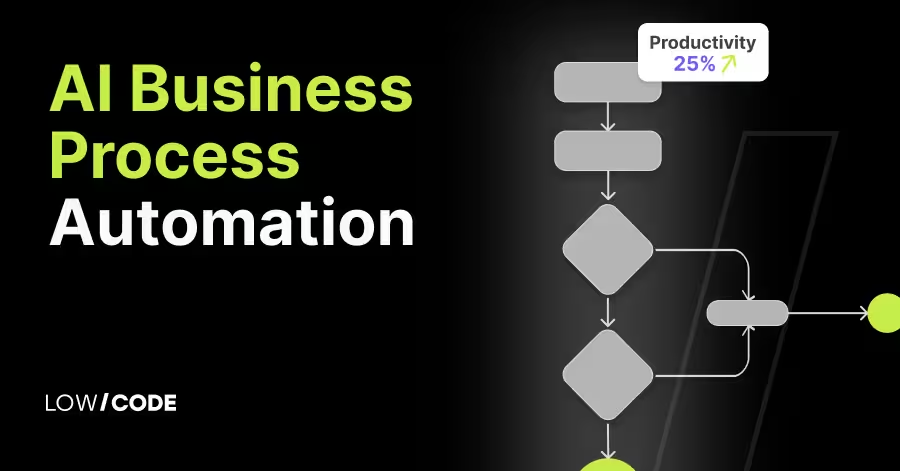How to Build AI-Powered Mobile Apps in 2025
13 min
read
Learn how to build AI-powered mobile apps in 2025 using no-code tools like Bubble, FlutterFlow, and Glide. Explore features, real-world use cases, and common mistakes to avoid
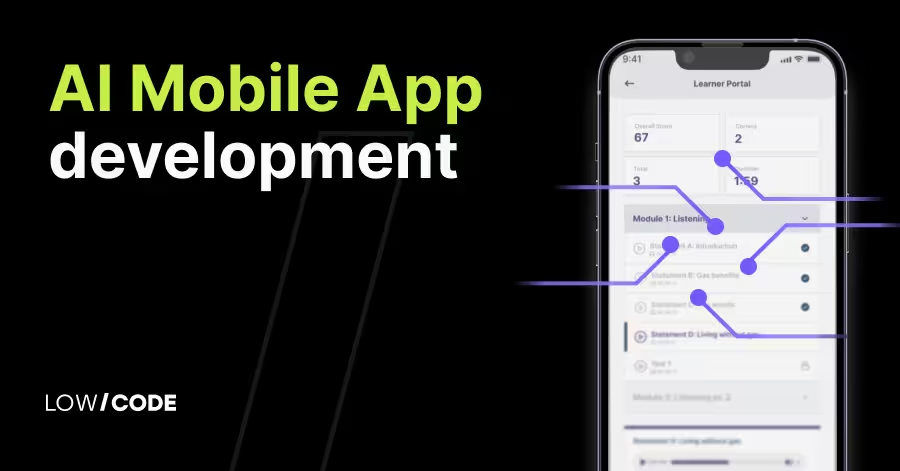
What Is AI Mobile App Development?
AI mobile app development means building apps that use artificial intelligence to think, learn, or make decisions. These apps go beyond simple tasks, they understand user behavior, respond in real-time, and improve over time.
AI is used in many mobile apps you see today, as
- Chatbots for 24/7 customer support
- Prediction tools that offer smart suggestions
- Voice recognition for hands-free controls
- Image recognition for scanning or visual searches
These features make apps faster, smarter, and more personal. With no-code platforms, even AI tools like OpenAI or Google Cloud AI can be added to apps using API connectors, saving months of manual development work.
Partner with LowCode Agency to Build AI Mobile Apps
At LowCode Agency, we specialize in transforming innovative ideas into powerful AI-driven mobile applications using cutting-edge no-code platforms. With over 330 successful projects across industries, we've partnered with startups and established businesses to harness the power of artificial intelligence without the complexity of traditional development.
Our expert team combines deep technical knowledge with strategic business insight to build mobile apps that don't just work; they intelligently adapt and grow with your users. We leverage platforms like FlutterFlow, Bubble, and Glide to integrate AI capabilities including chatbots, AI agents, predictive analytics, and machine learning algorithms into native mobile experiences.
Ready to transform your mobile app idea into an AI-powered reality? Book a free discovery call with our team today and let's discuss how we can bring intelligent automation and personalization to your mobile experience.
Why Add AI to Your Mobile App?
Adding artificial intelligence to your mobile app isn't just about following trends, it's about creating meaningful value for your users while streamlining your business operations. AI transforms how people interact with mobile technology, making experiences more intuitive and efficient.
Here's how AI can revolutionize your mobile app:
- Better user experience: AI creates smoother, more intuitive interfaces that adapt to individual user preferences and behaviors.
- Personalized content and automation: Deliver tailored content, recommendations, and automated workflows that feel custom-built for each user
- Save time and reduce manual work: Automate repetitive tasks, data entry, and customer support processes to free up your team for strategic work
- Smarter in-app search and navigation: Enable natural language queries and intelligent content discovery that helps users find what they need faster
- Predict user behavior and needs: Anticipate what users want before they ask, creating proactive experiences that delight and retain customers
- Boost engagement with real-time suggestions: Provide contextual recommendations and smart notifications that keep users actively engaged with your app
- Enable advanced features like voice and image recognition: Integrate cutting-edge capabilities that create competitive advantages and new use cases
- Improve security and fraud detection: Implement intelligent monitoring systems that protect user data and prevent unauthorized access
Read more | AI Business Trends and Challenges
Platforms That Let You Build AI-driven Mobile Apps
Building AI-powered mobile apps doesn't require years of coding experience or massive development teams. Modern no-code platforms now offer sophisticated AI integration capabilities that let you create intelligent mobile experiences quickly and efficiently.
These platforms provide pre-built AI components, seamless API integrations, and visual development environments that make artificial intelligence accessible to businesses of all sizes. You can implement chatbots, machine learning algorithms, and advanced automation without writing complex code.
1. Bubble
Bubble excels at creating sophisticated AI-powered applications with its robust workflow system and extensive third-party integrations. The platform's API connector allows seamless integration with OpenAI, Azure AI services, and other machine learning providers.
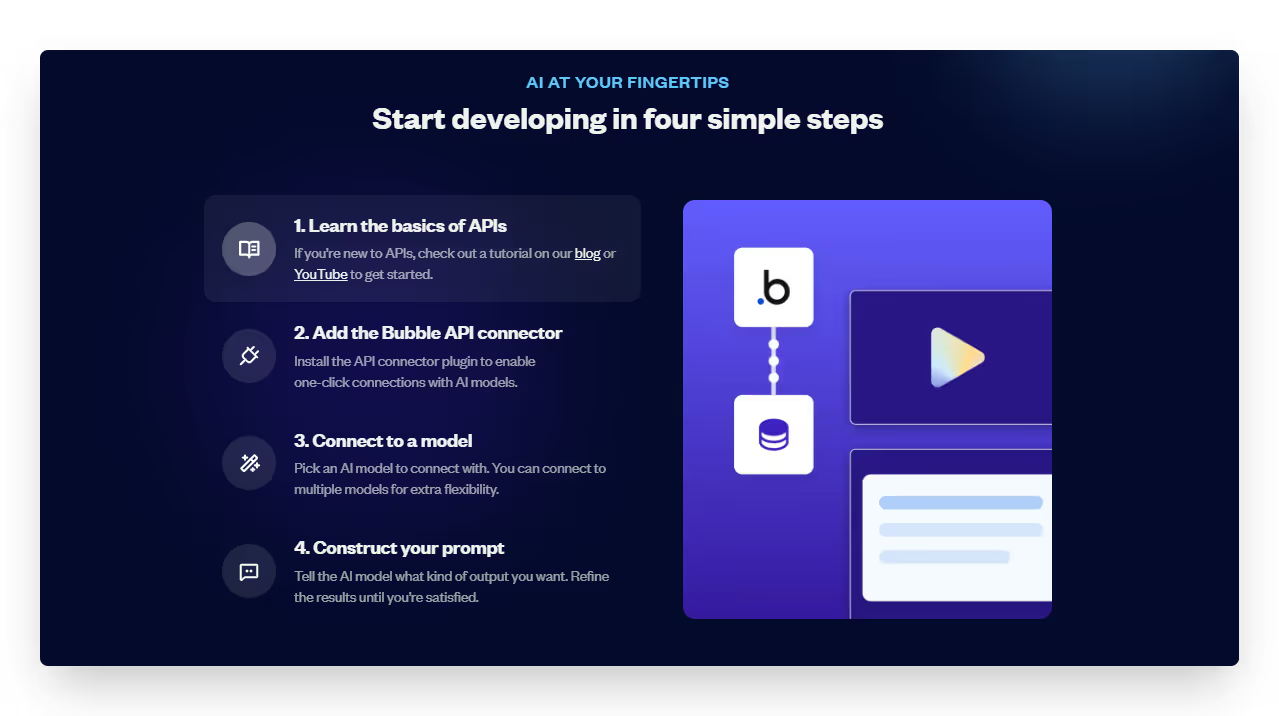
You can build complex AI workflows including chatbots, content generation, data analysis, and predictive features. Bubble's database capabilities handle large datasets efficiently, making it perfect for AI applications that require substantial data processing and storage.
Read more | AI Contract Management
2. FlutterFlow
FlutterFlow specializes in native mobile app development with built-in AI capabilities through its custom code editor and API integrations. The platform's AI Code Copilot generates Flutter code based on natural language descriptions, accelerating development significantly.
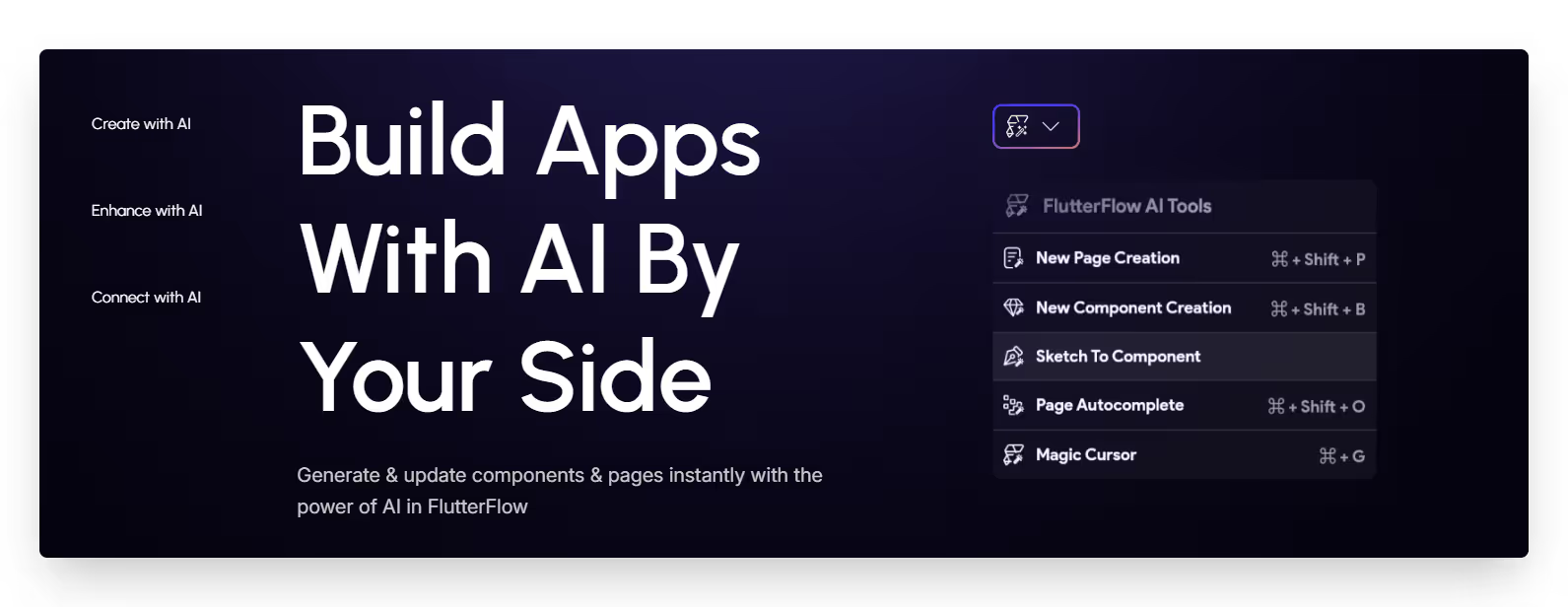
You can integrate computer vision, voice recognition, and machine learning models directly into native iOS and Android apps. FlutterFlow's real-time preview and collaboration features make it ideal for teams building AI-enhanced mobile experiences.
Read more | AI-Powered App for Lawyers (No-code)
3. Glide
While Glide doesn't create native mobile apps, it excels at building progressive web apps with AI functionality that work seamlessly across all devices. The platform's spreadsheet-based approach makes it perfect for data-driven AI applications and internal business tools.
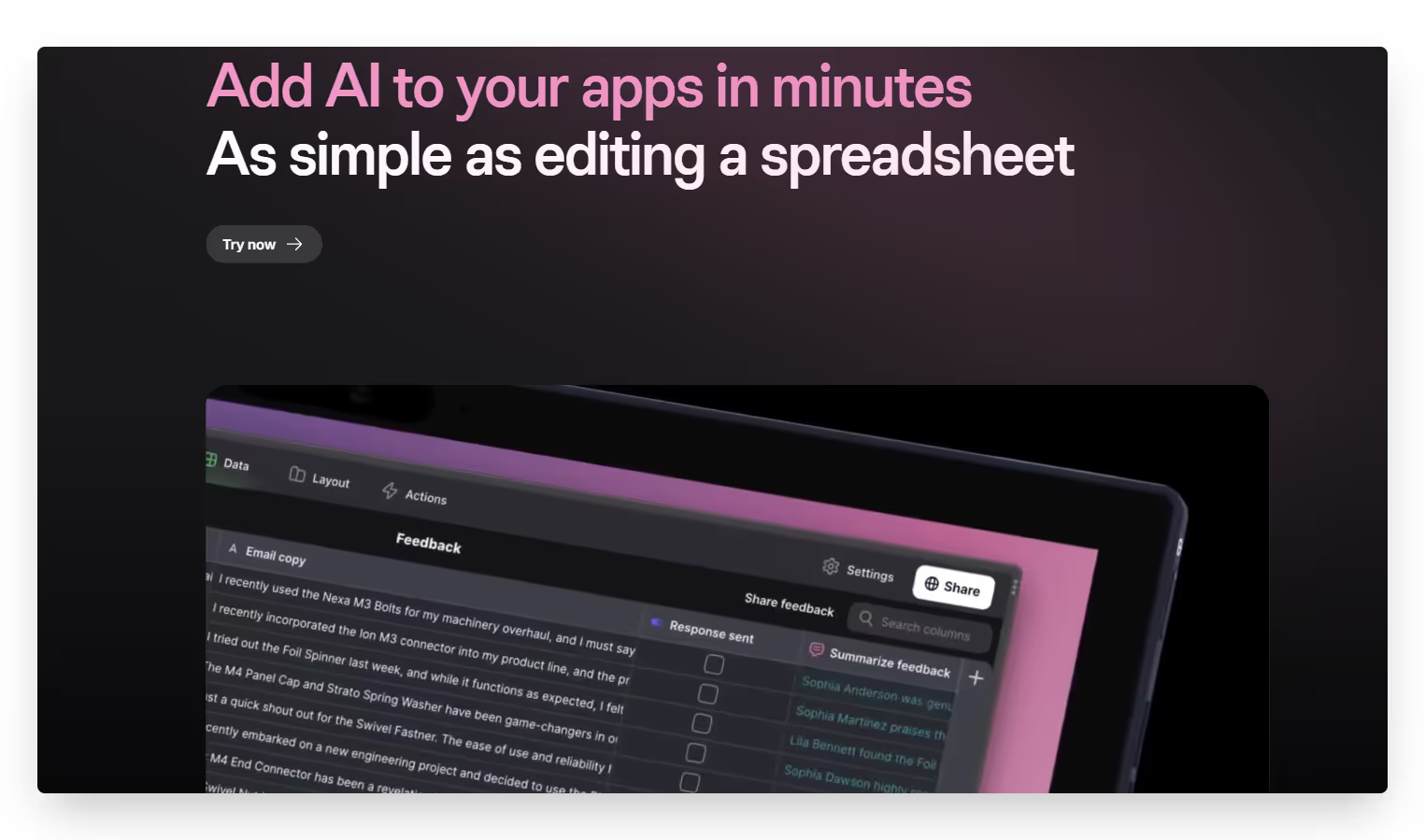
Glide's simple integration with AI services allows you to add chatbots, automated workflows, and intelligent data processing to your web-based mobile experiences quickly and cost-effectively.
Read more | AI App Development Guide
AI Tools You Can Integrate with No-code Platforms
The real power of AI mobile apps comes from using specialized AI tools through simple API connections, no need to build models from scratch.
Most no-code platforms offer built-in connectors, making it easy to combine top AI services and build smart, enterprise-grade mobile experiences.
1. OpenAI / ChatGPT – for chatbots, content, summaries
OpenAI’s ChatGPT can power smart chatbots, generate custom content, and summarize long texts. With no-code platforms like Bubble, you can connect to OpenAI's API to create real-time AI chat features. It helps with customer support, knowledge base search, or onboarding flows.
You can also use it to rewrite user inputs or analyze messages for tone and meaning. Just use API connectors or plugins to make the integration simple, no coding required.
Read more | Best No-code Mobile App Builders
2. Google Cloud Vision / ML Kit – image analysis, OCR
Google Cloud Vision and ML Kit are great for image-based features like scanning IDs, receipts, or documents. They support OCR (optical character recognition) to pull out text from images. Glide and FlutterFlow allow direct Firebase integration, making ML Kit setup smooth.
This is useful for insurance, health, or logistics apps that rely on photo inputs. With a few clicks, you can connect mobile camera features to Google’s AI, giving your app smart vision instantly.
Read more | Cross-Platform Mobile App Development Guide
3. Speech-to-Text / Text-to-Speech APIs – Google, AssemblyAI
These tools help your app understand or speak words. With Google Cloud or AssemblyAI APIs, you can add speech-to-text to let users speak instead of typing. Text-to-speech makes apps more accessible by reading out content.
Using Bubble or FlutterFlow, these features can be added through API calls. They are useful in hands-free apps, accessibility tools, or support features where voice commands make things faster and easier for users.
Read more | How to hire mobile app developers
4. Dialogflow – natural conversations (FlutterFlow)
Dialogflow by Google helps build smarter, more natural conversations in apps. It understands what users say and replies with logic-driven answers. FlutterFlow offers built-in support to connect Dialogflow, making it easy to create voice or chat interfaces that feel human.
You can use it to build appointment booking bots, insurance claim helpers, or onboarding guides. It gives your app an interactive voice without needing to write complex code.
Read more | Native mobile app development
5. Make.com or Zapier – for AI automation with external tools
Make and Zapier connect your app to hundreds of AI tools like ChatGPT, Google AI, or custom models. You can build workflows like “Send summary to ChatGPT and save to Google Sheets” or “Run image scan and notify support.”
With no-code platforms, these automation tools help move data between systems without backend work. It’s a fast way to scale AI use without managing servers or writing scripts.
Read more | No-code mobile app development guide
6. Peltarion, Hugging Face APIs – advanced AI models
Platforms like Hugging Face or Peltarion host advanced AI models for tasks like emotion detection, translation, or image tagging. You can connect them to no-code apps like Bubble using API calls.
This allows you to run powerful models directly in your app interface. For example, a health app can analyze mood from text inputs or a media app can tag photos automatically. These tools bring deep AI power to your project—without needing a full AI team.
Read more | AI business process automation guide
Step-by-Step: How to Build an AI-Powered Mobile App
Building an AI-powered mobile app might seem complex, but breaking it down into manageable steps makes the process straightforward and achievable. The key is choosing the right foundation and approaching development strategically.
1. Choose a platform (Bubble, FlutterFlow, or Glide)
Start by selecting the no-code platform that best matches your project requirements and technical goals. Evaluate each platform's AI integration capabilities, your team's technical expertise, and your timeline constraints.
FlutterFlow excels for Flutter-native mobile experiences, Bubble handles complex AI workflows with native mobile app capabilities, and Glide offers rapid deployment for simpler AI-enhanced progressive web apps.
Consider your long-term scaling needs and budget. Some platforms offer more flexibility for future AI enhancements, while others provide faster initial development but may require migration as your needs grow.
Read more | AI fitness app development guide
2. Define Core App Logic
Map out your app's essential functions before adding AI layers. Identify which processes would benefit most from artificial intelligence: customer support, content personalization, data analysis, smart chatbots or user onboarding.
Design your user flows to incorporate AI naturally rather than forcing it into every interaction. Focus on areas where AI genuinely improves the user experience or solves specific business problems your manual processes can't handle efficiently.
Document how AI features will interact with your existing data structures and user workflows. This foundation ensures AI enhances rather than complicates your app's core functionality.
3. Partner with AI Experts
Working with experienced AI developers accelerates your project timeline and prevents costly mistakes. Expert teams understand which AI tools work best for specific use cases and can implement complex integrations efficiently.
At LowCode Agency, we've built over 330 apps and integrated AI capabilities into numerous projects, giving us deep insight into what works and what doesn't. As your partners, we choose with you the right AI services, implement them correctly, and optimize performance from day one.
Professional AI integration ensures your app scales properly, maintains security standards, and delivers consistent user experiences across different devices and usage patterns.
Read more | How to hire AI app developers
4. Test Responses and Performance
Thoroughly test your AI features with real user scenarios before launch. Monitor response times, accuracy rates, and user satisfaction to identify areas needing optimization or refinement.
Set up analytics to track how users interact with AI features and whether they're achieving your intended business outcomes. Test edge cases and unexpected user inputs to ensure your AI responds appropriately.
Plan for ongoing monitoring and improvement. AI performance often improves over time with more data and user feedback, so build systems that let you refine and enhance functionality post-launch.
Read more | How to hire Bubble developers
AI Features You Can Add to Your Mobile App
Modern AI makes mobile apps smarter by automating tasks and predicting user needs. The key is to choose AI features that solve real problems, streamlining workflows and adding real value for your users.
Here are the most impactful AI features you can integrate into your mobile app:
- Chatbot with ChatGPT: Provide instant customer support, answer complex questions, and guide users through app features with conversational AI that feels natural and helpful
- Smart form responses: Auto-populate forms based on user history, validate inputs in real-time, and suggest corrections to reduce errors and completion time
- Document scanning and extraction: Use computer vision to scan receipts, contracts, or business cards and automatically extract key information into structured data
- AI voice input/output: Enable hands-free interactions through speech recognition and text-to-speech capabilities that make your app more accessible and convenient
- Auto-suggestions and predictive text: Anticipate what users want to type or search for, speeding up interactions and improving overall user experience
- AI-based recommendations: Analyze user behavior patterns to suggest relevant content, products, or actions that increase engagement and conversion rates
- Anomaly detection in reports: Automatically identify unusual patterns in data, flagging potential issues or opportunities that might otherwise go unnoticed
- Automated meeting summaries: Process audio recordings or transcripts to generate concise summaries, action items, and key takeaways from business meetings
- Email and message classification: Automatically categorize, prioritize, and route communications based on content analysis and urgency levels
- Real-time language translation: Break down language barriers with instant translation capabilities that enable global user engagement and accessibility
Read more | How to hire no-code developers
Best Use Cases for AI-Powered Mobile Apps
AI brings real intelligence to apps by handling tasks that once needed human effort. These use cases show how AI can deliver real value across different industries and audiences.
1. AI-powered mental wellness coaches
AI-powered mental health apps can offer 24/7 support through guided conversations, emotion tracking, and self-care tools. Using NLP and sentiment analysis, these apps respond in a human-like way to user inputs.
With no-code platforms like Bubble, you can integrate ChatGPT to create personalized check-ins, mood logs, and breathing exercises. These apps are private, accessible, and helpful for users who may not be ready to speak to a live therapist. They provide emotional support, habit building, and mental clarity at the user’s pace.
2. Customer support chat apps
AI chat apps improve customer service by answering common questions, resolving issues, and managing tickets automatically. Using tools like Dialogflow or OpenAI, no-code builders can create bots that handle high volumes of user queries without delay. These apps respond instantly, reduce support workload, and stay active 24/7.
With smart workflows and API calls, apps can also check order status or update user info. This makes support faster, more efficient, and more reliable—especially for service-based businesses or eCommerce platforms.
3. AI learning and tutoring apps
AI-powered tutoring apps can explain lessons, give practice questions, and adjust teaching speed based on the learner’s needs. No-code tools let you connect to OpenAI for real-time Q&A or feedback.
You can build language learning, coding help, or test prep apps that react to each user's performance. These apps use voice input, quizzes, and adaptive logic to guide learning better than static content.
They help users stay engaged and improve faster, with a personal learning assistant always ready in their pocket.
4. Inventory or document scanners
Apps that scan and understand documents or barcodes are useful in retail, insurance, and finance. With Google Cloud Vision or ML Kit, you can build scanners that extract text, detect items, or pull data from forms.
No-code platforms like FlutterFlow or Glide support Firebase-based integrations for easy setup. Users can scan bills, receipts, or handwritten forms directly in the app.
The AI then processes the image and updates the app’s database in seconds, reducing human error and saving time.
5. Productivity tools with smart reminders
AI makes productivity apps smarter by learning habits and creating helpful suggestions. Instead of simple alarms, AI reminders adjust based on user behavior, like work hours or missed tasks.
You can connect tools like AssemblyAI or OpenAI in Bubble to manage tasks, set goals, and deliver reminders when they’re most useful.
These apps help reduce overload by reminding users at the right time, predicting delays, or suggesting reschedules. It’s perfect for freelancers, busy teams, or anyone who wants better time control.
Read more | How to hire FlutterFlow developers
Common Mistakes to Avoid
Building AI-powered mobile apps needs smart planning. Rushing into AI without thinking through challenges can cause poor user experiences, bugs, and expensive rebuilds. Knowing common mistakes helps you build apps that work better and give lasting value.
- Relying on AI too early in the workflow: Don't use AI as the first step in critical processes; establish solid foundation logic and data validation before introducing artificial intelligence components
- Not validating AI results before acting on them: Always implement verification systems to check AI outputs for accuracy, relevance, and safety before presenting results to users or triggering automated actions
- Placing AI outputs in the wrong step: Position AI features where they add genuine value rather than forcing them into processes where traditional logic would be more reliable and efficient
- Failing to define clear AI entry/exit points: Establish specific triggers for when AI should activate and clear pathways for users to bypass or override AI decisions when necessary
- No workflow fallback when AI fails or times out: Design backup systems that maintain app functionality even when AI services are unavailable, slow, or producing errors
- Chaining too many AI steps without testing edge cases: Avoid creating complex AI sequences where one failure can break the entire workflow; test unusual inputs and unexpected user behaviors thoroughly
Cost Breakdown of Building AI Apps
Building an AI mobile app isn’t just about picking a platform, it’s about balancing features, timelines, and long-term goals. Costs can vary widely based on the complexity of your AI tools, whether you're building an MVP or a full-scale product.
Estimated MVP Cost Range
An AI-powered MVP typically starts at $30,000 and takes 8–12 weeks to build. This version focuses on essential features like basic chatbots, recommendation engines, or simple AI-driven workflows.
- No-code platform costs: $25–$100/month
- AI service costs: $20–$200/month based on usage
This setup helps validate your idea quickly while keeping your initial investment low. It’s ideal for early-stage testing and gathering user feedback.
Estimated Full-Scale Product Cost Range
A full-featured AI app with advanced tools like computer vision, voice recognition, or predictive analytics ranges from $50,000 to $80,000+.
- No-code platform costs: $100–$400/month for enterprise use
- AI service costs: $500–$2,000/month for high-volume tasks
Full builds require stronger infrastructure, handle more users, and rely on advanced models, making them powerful but more costly.
Read more | Best no-code AI app builders
Market Trends and Future of AI in Mobile Apps
AI is becoming a major part of mobile app development. These trends show how quickly it is changing the way apps are built and used, especially when combined with no-code tools.
- AI-powered apps are scaling fast
AI is helping apps grow across industries like healthcare, finance, and retail. Businesses are using AI to offer smarter, faster, and more helpful services to users. - The rise of no-code + AI platforms
Tools like Bubble, Glide, and FlutterFlow now support AI integrations through easy APIs. This allows non-coders to build smart apps with features like chatbots and predictions. - Why businesses are adopting AI faster
AI lowers costs, speeds up tasks, and improves customer satisfaction. As tools become more affordable and easier to use, more companies are adding AI to their apps. - Expect more personalized, predictive apps
AI will help apps learn from user behavior and offer tailored content, reminders, or suggestions based on real-time data. - Edge AI and on-device intelligence
More apps are starting to process data directly on the phone instead of the cloud. This improves speed and protects user privacy. - AI + voice and vision will go mainstream
Features like voice commands and image recognition will soon be standard in most apps, making them more interactive and user-friendly.
Final Thoughts
The integration of artificial intelligence into mobile applications isn't just a technological trend; it's becoming a business necessity. Companies that embrace AI-powered mobile experiences today are positioning themselves for sustainable competitive advantages tomorrow.
At LowCode Agency, we've mastered the art of integrating artificial intelligence into mobile applications using powerful no-code platforms. Our team combines deep AI expertise with proven development methodologies to build intelligent apps that deliver real business value from day one.
We don't just add AI features; we strategically implement intelligent capabilities that solve specific business problems and create meaningful user experiences.
Ready to transform your mobile app with AI?
Book a free discovery call with our experts and discover how we can transform your mobile app idea into an intelligent, AI-powered reality that drives real business results.
Created on
July 22, 2025
. Last updated on
December 5, 2025
.

FAQs
What is AI mobile app development?
Can I build an AI mobile app without coding?
What are some common AI features in mobile apps?
How do I connect AI tools like ChatGPT to my app?
Which platform is best for AI mobile app development?
How much does it cost to build an AI-powered app?





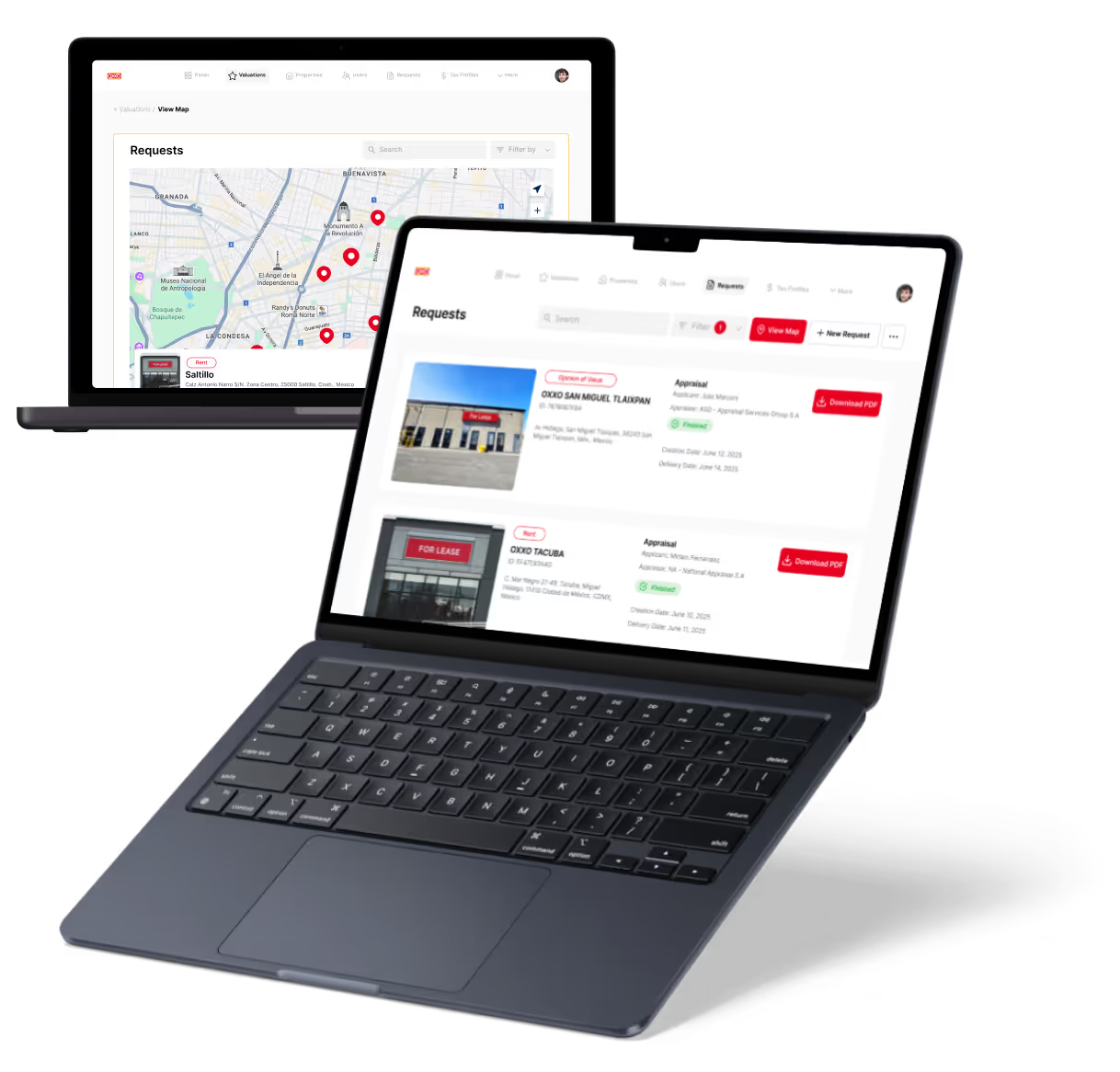

%20(Custom).avif)







